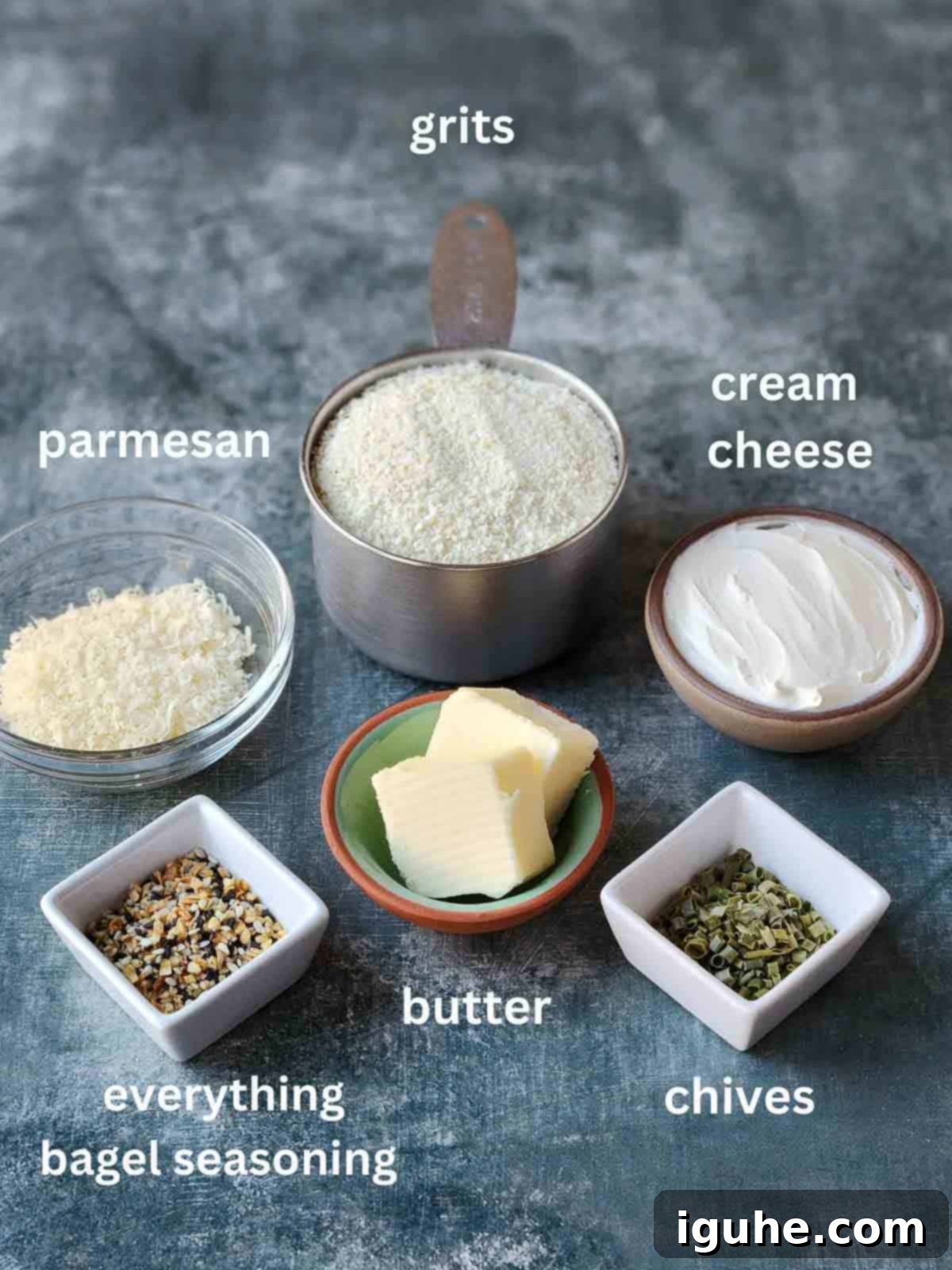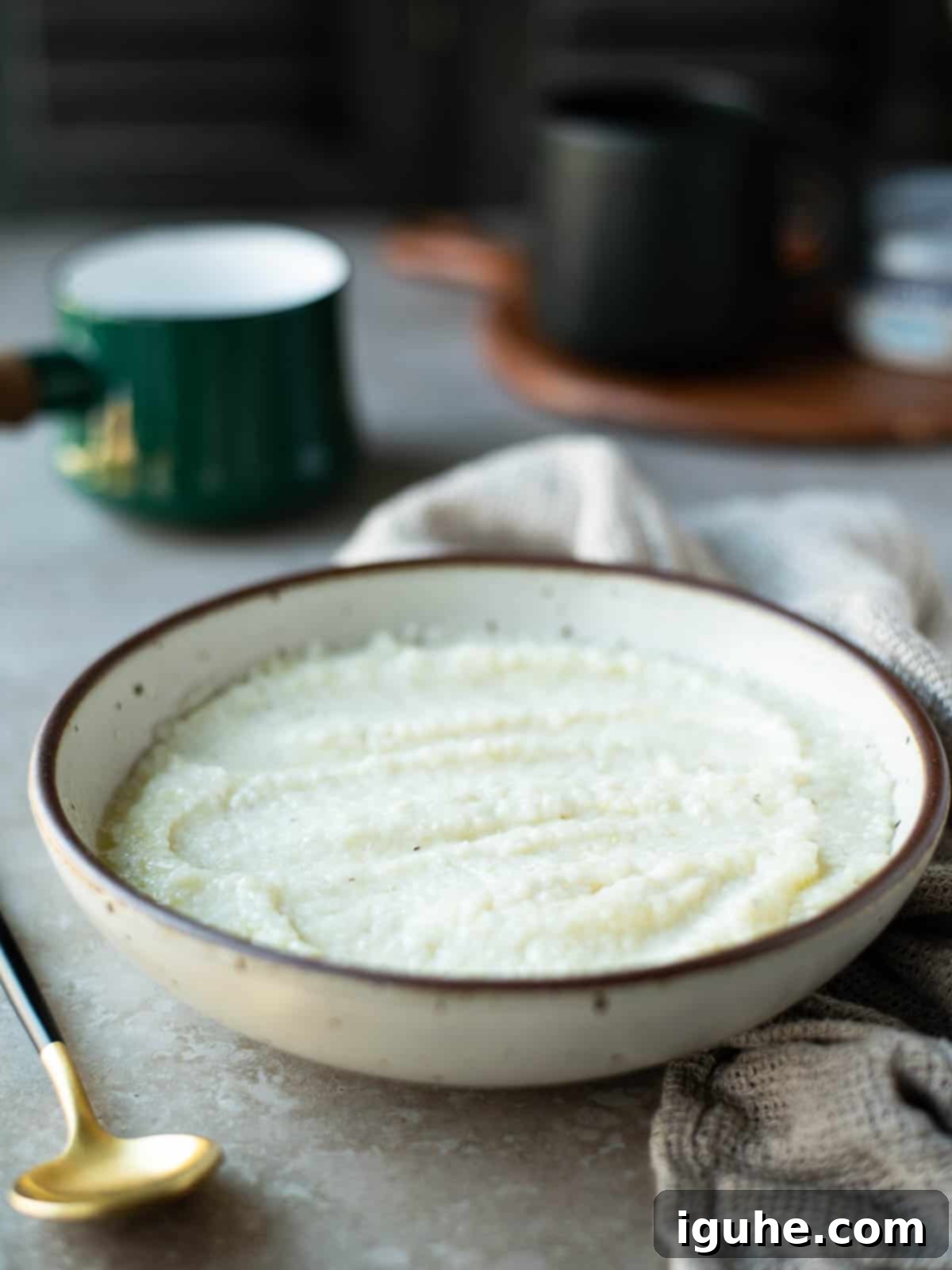Savory Breakfast Perfection: Creamy Everything Bagel Grits Recipe
Imagine your favorite cream cheese bagel, but in a warm, comforting bowl of grits. That’s exactly the inspiration behind these incredibly decadent Cream Cheese Grits with Everything Bagel Seasoning. This innovative recipe takes a beloved Southern staple and infuses it with the irresistible flavors of a classic New York bagel. Made with a rich blend of cream cheese, parmesan, and butter, then generously topped with aromatic everything bagel spice, this dish promises a breakfast experience like no other. For a truly complete and satisfying meal, simply add a sprinkle of fresh chives and a perfectly cooked egg on top.

You certainly don’t have to be a Southerner to fall in love with grits. This humble grain, made from finely ground corn, has a naturally coarse texture. However, when cooked with the right liquids and fats – be it water, milk, cream, butter, cheese, or stock – it undergoes a magical transformation. The result is a smooth, velvety, and incredibly comforting consistency that forms the perfect canvas for a myriad of flavors, especially savory ones.
Our cream cheese grits take this comfort food to an entirely new level. They are an undeniably creamy and rich option, making them the ultimate foundation for a hearty and satisfying breakfast bowl. The clever addition of everything bagel seasoning isn’t just an afterthought; it’s the star player that perfectly unifies all the savory elements, providing a delightful textural crunch and a burst of iconic flavor. Get ready to elevate your breakfast game with this surprisingly easy and utterly delicious recipe!
Jump to: Recipe Card
What Are Grits and Why We Love Them?
Grits are a staple in Southern American cuisine, but their appeal extends far beyond regional borders. This versatile dish originates from ground corn, typically hominy, which is corn that has been treated with an alkali process (nixtamalization) to remove the hull and germ. This process not only makes the corn more nutritious but also gives grits their distinctive flavor and texture.
There are several types of grits available, and understanding the differences can significantly impact your final dish:
- Stone-Ground Grits: These are the least processed, with irregularly sized corn particles. They have a hearty, robust corn flavor and a chewier texture. They require the longest cooking time but yield the most authentic and flavorful results.
- Old-Fashioned Grits: Also known as regular grits, these are ground a bit finer than stone-ground but still offer a good texture and flavor. They cook faster than stone-ground but still retain much of the corn’s integrity.
- Quick-Cooking Grits: These are finer still and have been processed to cook more rapidly, typically in 5-10 minutes. They are a great compromise for those short on time but still want a satisfying texture.
- Instant Grits: These are highly processed, pre-cooked, and dehydrated. While convenient, they often lack the depth of flavor and creamy texture of other types, which is why we recommend avoiding them for this particular recipe.
When cooked, grits absorb liquid and swell, transforming from gritty kernels into a luxuriously smooth and creamy porridge. They are incredibly versatile, serving as a base for sweet dishes (with sugar and fruit) or, as in this recipe, a savory canvas for cheese, spices, and proteins. Their ability to soak up rich flavors makes them a perfect vehicle for the cream cheese and everything bagel seasoning.
What is Everything Bagel Seasoning?
Everything bagel seasoning has taken the culinary world by storm, moving far beyond its humble origins on a New York-style bagel. This iconic spice blend is a one-stop flavor powerhouse, perfect for bagels, toast, eggs, avocado, and essentially anything you want to infuse with a bold, kicked-up taste and texture. Its popularity exploded thanks to its simple yet incredibly effective combination of ingredients that hit all the right notes: savory, nutty, garlicky, and oniony.
Typically, a classic everything bagel seasoning blend consists of:
- White Sesame Seeds: For a mild, nutty flavor and a slight crunch.
- Black Sesame Seeds: Adding a deeper, earthier sesame note and visual contrast.
- Poppy Seeds: Providing a subtle crunch and a delicate, slightly nutty taste.
- Dried Minced Garlic: Delivering a pungent, savory kick that’s essential to the blend.
- Dehydrated Onion Flakes: Offering a sweet, savory, and slightly sharp onion flavor.
- Flaked Sea Salt: A crucial element that ties all the flavors together and enhances their impact.
The beauty of this seasoning lies in its balanced textural contrast and complex flavor profile. It’s readily available in most grocery stores now, often found in the spice aisle or specialty food shops. Trader Joe’s “Everything But The Bagel” seasoning is particularly famous, but many other brands offer excellent versions, and you can even find it conveniently online, like on Amazon. Making your own blend is also incredibly simple if you have the individual ingredients on hand!
Ingredient Notes
Crafting the perfect bowl of creamy cheese grits starts with understanding your ingredients. Here’s a closer look at what you’ll need and why specific choices make a difference in this delightful recipe. Full ingredients and detailed instructions can be found in the recipe card below.

- Grits: The foundation of our dish! We recommend using stone-ground, white corn, old-fashioned, or quick-cooking grits. These varieties offer the best balance of texture and cooking time for truly creamy results. Absolutely avoid instant grits here, as their finely processed nature makes them less flavorful and often leads to a gummy texture rather than a creamy one. You’ll typically find grits in the breakfast or baking aisle of your grocery store. Popular and reliable brands include Quaker, Bob’s Red Mill, or Palmetto Farms. Always choose plain grits and avoid any flavored varieties, as we’ll be adding our own rich flavors.
- Cream Cheese: This is where the “cream cheese” in cream cheese grits comes from! You can use either full-fat or reduced-fat cream cheese. Full-fat will, of course, provide a richer, more luxurious mouthfeel, but reduced-fat still delivers that tangy creaminess. Ensure it’s softened slightly to blend seamlessly into the hot grits.
- Parmesan: Freshly grated parmesan cheese is key. Its sharp, salty, and umami notes add a wonderful depth of flavor that complements the richness of the cream cheese perfectly. Pre-grated parmesan often contains anti-caking agents that can affect texture, so grate it yourself for the best outcome.
- Butter: We recommend using unsalted butter. This allows you to control the overall saltiness of the dish, especially since parmesan and everything bagel seasoning also contribute salt. Butter adds an irreplaceable velvety texture and a comforting richness.
- Everything Bagel Seasoning: This is the magic ingredient that brings everything together! As discussed, it’s widely available in specialty stores, online (like the famous Trader Joe’s “Everything But The Bagel” blend), or you can easily whip up your own. Its blend of sesame seeds, poppy seeds, dried garlic, and onion adds both crunch and an explosion of savory flavor.
- Chives: Fresh chopped chives are used as a vibrant, fresh topping. Their mild oniony flavor and bright green color provide a beautiful contrast and an appealing aromatic finish. Dried chives can be used in a pinch, but fresh is highly recommended for impact.
- Salt: Essential for seasoning to taste. We specify Kosher or fine sea salt in the recipe card as a starting point. Remember that grits themselves are bland and need proper seasoning, and both the parmesan and everything bagel seasoning contain salt, so adjust carefully.
Instructions: Crafting Your Creamy Everything Bagel Grits
Making these cream cheese grits is surprisingly straightforward, and the process is quite forgiving. The key is to start with well-cooked grits and then integrate the dairy and seasoning for that ultimate creamy, flavorful finish. Here’s a general overview, with precise measurements and steps available in the recipe card below.
The first and most crucial step is to prepare your chosen grits according to the specific directions provided on their package. Different types of grits (stone-ground, old-fashioned, quick-cooking) have varying liquid-to-grits ratios and cooking times. Follow these instructions closely to ensure your grits are fully cooked and tender before moving to the next steps. This often involves bringing liquid (water, milk, or stock) to a boil, slowly whisking in the grits, reducing heat, and simmering, stirring occasionally until thick and creamy.

Once your grits are perfectly cooked and tender, remove them from the heat. This is the moment to incorporate the creamy elements: add the softened cream cheese, freshly grated parmesan, and a generous knob of butter. The residual heat from the grits will help these ingredients melt beautifully.

Stir everything together vigorously until the cream cheese, parmesan, and butter are completely melted, thoroughly blended, and the grits achieve a luxuriously smooth, creamy consistency. Finally, divide the grits among serving bowls and generously top each with a sprinkle of everything bagel seasoning, fresh chopped chives, and additional salt to taste. Serve immediately to enjoy them at their absolute best!
👩🍳Expert Tip for the Creamiest Grits
To achieve truly unforgettable, ultra-creamy grits, consider replacing some or all of the water in your grits recipe with whole milk, half-and-half, or even a rich chicken or vegetable stock. Additionally, don’t rush the cooking process. Simmer your grits for a bit longer than the package states, stirring frequently and adding more milk or stock as needed to maintain a loose, flowing consistency until they reach your desired level of tenderness and creaminess. The longer, slower cook time helps the corn particles fully break down and release their starches, resulting in a silkier texture.
Substitutions and Variations
This recipe is incredibly versatile and open to creative twists! Feel free to experiment with these substitutions and variations to tailor the Cream Cheese Grits with Everything Bagel Seasoning to your personal preferences.
- Polenta: If grits aren’t readily available, or if you simply want to try something different, polenta makes an excellent substitute. Look for stone-ground polenta, which can be either coarse or fine. Adjust the cooking time and liquid ratios according to the package directions, as polenta often cooks similarly to grits, offering a slightly different corn flavor profile.
- Mascarpone: For an even more indulgent and luxurious breakfast experience, swap out the regular cream cheese for rich, buttery Italian mascarpone cheese. Mascarpone will lend an unparalleled velvety texture and a subtle sweetness, making your grits truly decadent.
- Cheesy Boost: Beyond parmesan, consider adding a handful of other melty cheeses like sharp cheddar, smoked gouda, or Monterey Jack for an extra cheesy kick and nuanced flavor.
- Seasoning Alternatives: If you don’t have everything bagel spice on hand, you can easily create a similar flavor profile using individual spices. A mix of sesame seeds (white and/or black), poppy seeds, garlic powder, and dried onion flakes will give you a close approximation. Alternatively, for a simpler approach, you could skip the everything bagel spice altogether and simply season your creamy grits generously with salt and freshly ground black pepper to taste, perhaps with a dash of onion powder.
- Herbacious Twist: Beyond chives, fresh herbs like finely chopped dill, parsley, or even a hint of rosemary can add another layer of fresh, aromatic flavor to your finished grits.
- Spicy Kick: For those who love a bit of heat, a pinch of red pepper flakes stirred into the grits or sprinkled on top alongside the everything bagel seasoning can provide a welcome spicy dimension.
How to Serve Cream Cheese Grits
These creamy everything bagel grits are a star on their own, but they truly shine when paired with other complementary breakfast or brunch items. Here are some delicious ideas to complete your savory grits experience:
- Eggs, Any Style: A classic pairing for grits! Add a perfectly fried egg with a runny yolk to mingle with the creamy grits, or opt for a delightful jammy egg for a soft, custardy texture. Scrambled or poached eggs also work wonderfully for a complete and savory breakfast bowl.
- Savory Veggies: Elevate your meal with some tender, flavorful vegetables. This sweet and tangy cherry tomato confit or richly flavored slow-roasted beefsteak tomatoes are perfect veggie companions, adding a burst of freshness and acidity that cuts through the richness of the grits.
- Crispy Bacon: No savory breakfast is complete without bacon! Crumble some crispy fried bacon on top of your grits for a salty, smoky crunch. For an extra special treat, try a few strips of rosemary and fig candied bacon for a sweet and savory contrast.
- Sausage or Ham: Cooked breakfast sausage patties or crumbles, or even diced ham, can add a hearty protein element that makes these grits a truly filling meal.
- Buttered Toast: Keep it simple yet satisfying. Serve your creamy grits alongside a slice of perfectly golden, buttered toast (perhaps with some homemade smoked chive butter!) for dipping and soaking up every last bit of deliciousness.
- Hot Sauce: For those who enjoy a little heat, a few dashes of your favorite hot sauce can add a fantastic zing and depth to the creamy grits.

Storage and Reheating Tips for Grits
While these cream cheese grits are best enjoyed fresh off the stove, you can certainly store leftovers for another delightful meal. Properly storing and reheating them ensures they retain as much of their delicious flavor and texture as possible.
Store any leftover grits in an airtight container in the refrigerator for up to 5 days. Make sure they cool down completely before sealing and refrigerating to prevent condensation and maintain food safety.
When you’re ready to reheat the grits, you’ll notice they’ve thickened considerably in the fridge. This is normal, as the cornstarch continues to set. To restore their creamy consistency, simply add a splash of water, milk, or even a bit of stock before warming them. You can reheat them in the microwave, stirring every minute or so, or gently warm them on the stovetop over low to medium heat. Continue stirring and adding liquid until they reach your desired creamy texture and are heated through. Be careful not to overheat, as this can cause them to become dry or rubbery. A small pat of butter or an extra sprinkle of everything bagel seasoning can also revive their flavor during reheating.
Frequently Asked Questions About Grits
Here are some common questions about grits and their preparation to help you master this comforting dish:
While both grits and cornmeal are indeed made from ground corn, they are not quite the same. The primary difference lies in how the corn is processed and its texture. Cornmeal can range from fine to coarse ground and is most commonly used in baking for items like cornbread, as a dusting agent, or for breading. Grits, particularly traditional Southern grits, are typically made from hominy (alkali-treated corn) and are ground to a specific consistency that, when cooked, becomes creamy. If you’re looking for a substitute for grits in a recipe like this, polenta would be a much closer match in texture and application than cornmeal.
Lumpy grits usually happen for a couple of reasons. First, adding grits too quickly to boiling liquid without whisking can cause them to clump. Always whisk them in slowly and continuously. Second, not stirring enough during the initial cooking phase can lead to lumps forming at the bottom of the pot. Ensure regular stirring, especially when they begin to thicken. Using sufficient liquid and cooking them slowly also helps to prevent lumps.
Absolutely, and it’s highly recommended for extra creamy and flavorful grits! Cooking grits in milk, half-and-half, or even stock instead of just water will significantly enhance their richness and overall taste. The expert tip above even suggests this for achieving maximum creaminess. Just be mindful that milk can scorch more easily than water, so stir more frequently when cooking with milk.
To prevent sticking, use a heavy-bottomed pot, which distributes heat more evenly. Stirring frequently, especially during the latter half of the cooking process when the grits are thickening, is also crucial. Adding a tablespoon of butter or oil to the cooking liquid can also help create a non-stick barrier and adds to the richness.
our favorite
Grits Pairings
These recipes pair so well with creamy grits
- Brussel Sprout Hash
- Heirloom Tomato Caprese Salad
- Kielbasa Reuben Sandwich
- Swiss Chard Eggs Florentine with Tomato Hollandaise
Did you make this recipe? I would love to hear about it! Please leave a ⭐⭐⭐⭐⭐ rating with a comment right below the recipe card. If you snap a photo of your creation, don’t forget to tag me on Instagram @brunchandbatter.
📖Recipe

Cream Cheese Grits with Everything Bagel Seasoning
Pin Recipe
Equipment
-
1 large pot
Ingredients
- 1 cup old-fashioned grits regular or quick-cooking (not instant)
- ¼ cup cream cheese
- 3 tablespoon grated parmesan cheese
- 2 tablespoon unsalted butter
- ¼ teaspoon Kosher or fine sea salt
- 2 teaspoon everything bagel seasoning
- 4 teaspoon chopped fresh chives
Instructions
-
Prepare the grits according to the package directions.1 cup old-fashioned grits
-
Remove from the heat and immediately add the cream cheese, parmesan cheese, butter, and salt. Stir until the cheese is melted and well incorporated.¼ cup cream cheese, 3 tablespoon grated parmesan cheese, 2 tablespoon unsalted butter, ¼ teaspoon Kosher or fine sea salt
-
Divide among 4 bowls and top each bowl with ½ teaspoon everything bagel seasoning, and 1 teaspoon fresh chives. Season to taste with additional salt, butter, or everything bagel seasoning. Serve immediately.2 teaspoon everything bagel seasoning, 4 teaspoon chopped fresh chives
Nutrition*
*Nutrition information is provided as a courtesy and is an estimate only. Nutrition information can vary depending on many factors, such as products used, measurements and substitutions, therefore it is recommended that you obtain nutritional calculations based on your own finished recipe.
